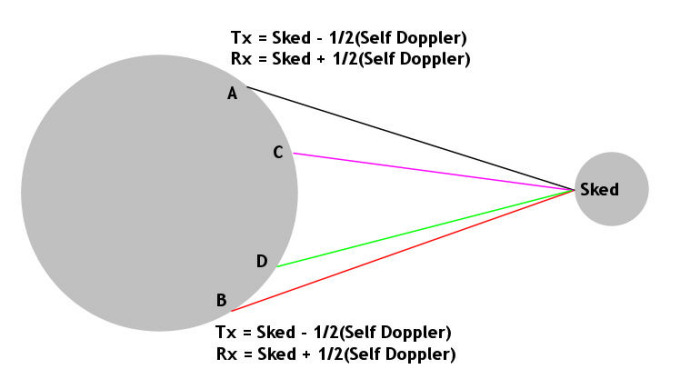CFOM - Constant Frequency On Moon Doppler Mode

For a CFOM contact, they'd be listening and transmitting on the CFOM Sked frequency...
WSJT-X contains a number of different Doppler modes, one of which is called CFOM, which stands for Constant Frequency On Moon. Though this mode is often used on the highest EME bands (e.g. 10Ghz), it's not used much (if at all) on 432MHz and lower. It's gaining popularity (2022) on 1296MHz. The lack of use, in part, may be due to a lack of understanding of why this mode is useful. This article is an attempt to explain why. It will be evident that it is of more use on the higher microwave bands where the rate of change of Dopper shift is higher. On the lower bands the small Doppler shifts means less attention needs to be paid to Doppler tracking.
First, what is it? In its most basic description, CFOM is just what the name implies. Suppose there was an EME station actually on the moon's surface. Now suppose there were two stations on Earth, call then A and B, both transmitting a signal at 1296.070 MHz. The station on the moon would hear both of them but on different frequencies due to different Doppler shifts from each station. If both stations were using CFOM Doppler mode with a Sked Frequency of 1206.070 mode, each would transmit on a different frequency, such that the station on the moon heard both of them at 1296.070.
They would do that by transmitting of a frequency of 1296.070 (the "sked" frequency), MINUS 1/2 of their Self Doppler correction, i.e. 1/2 of the Doppler correction they would use in order to hear their own echos. So if station A had a self Doppler shift of 2000Hz, they would transmit at 1296.069. If station B had a self Doppler of -1000Hz, they would transmit on a frequency of 1296.0705. The station on the moon would then hear both of them at 1296.070.
So far, so good, but nobody is actually listening on the moon, so what's the point? Where would station A hear station B and vice versa. Simple. Station A would hear station B at the Sked Frequency (which is the Frequency heard on the Moon) PLUS half of their self Doppler. So stations A would hear station B at 1296.071. What about station B? They would hear station A at the Sked Frequency (which is the Frequency heard on the Moon) PLUS half of their self Doppler. So station B would hear station A at 1296.0695.
Now here is the key point. Both stations calculated their TX and Rx frequencies without knowing where the other station was located. Their "Mutual Doppler" Or "Dx Doppler" was not required to know where to transmit or where to listed. As long as they both know the "sked" frequency and their own self Doppler frequency, they will both be on frequency. And this doesn't just apply to stations A and B. We can add stations C, D and E. We don't need to know where they are located. If they each calculate their own CFOM frequencies based on the sked frequency of 1296.070 all the stations will hear all the other stations at the same frequency. So if A transmits, B, C, D and E will all copy the signal. If B now transmits, A, C, D and E will copy that signal at the same frequency as they copied A. And so on for C, D and E transmitting.
Another way to look at this is whenever a station transmits on their CFOM calculated Tx frequency, they are setting up a "virtual" transmitter on the moon at the sked frequency. On receive, all the listening stations are listing to a "virtual" transmitter on the moon operating at the same sked frequency.
CFOM is also equivalent to using the "Full Doppler to DX" Doppler mode, but with the DX station located on the moon!

Each station will see a different Rx frequency on their radio dial (their own CFOM calculated frequency), but they will hear all the other stations on their calculated CFOM Rx frequency. When they transmit on their calculated CFOM Tx frequency (different for each stations), all the other stations will hear them at their own calculated CFOM Rx frequency.
So CFOM has two advantages over most other Doppler modes (such as "listening on my echo"):
[1] As long as both stations use CFOM, either they nor anyone else needs to know where the stations are located in order to know where to listen for them
[2] If multiple stations want to listen to a QSO (e.g. a world record attempt or a pair of QRP stations trying to make a contact) they all know where to listen without having to make complex Doppler calculations based on the location of the QRP station and re-tuning the rig to a different frequency for each station.
The re-tuning may be minor on the lower EME bands and not needed to see both signals within the receiver audio passband, but can be enough on the higher bands that without re-tuning the two signals cannot be seen in the same audio passband and re-tuning is required.
Caveat
There's one other important thing to note. Since the Tx station is trying to put a signal on the moon at the sked frequency, and The Tx frequency is based on the station's self Doppler, and that self Doppler is changing with time, to use CFOM effectively the transmitting station has to be able to change their Tx frequency while in Tx mode. Not all rigs can do this. For example my FT-897's frequency cannot be changed over a CAT link while the rig is in Tx mode. So, for example, if I was using the FT-897 as an IF for a 10 Ghz system, I would not be able to use the CFOM mode properly for a QSO. I would be able to listen to other stations using CFOM perfectly well since the FT-897 can change frequency in Rx mode via CAT at any time. However if I transmitted in CFOM mode, my Tx frequency would be constant and any station receiving the signal would see a frequency shift due to changes in Doppler shift during the transmission. So in that case using another mode would be a better choice. In "Own Echo" mode (i.e. listening on your own echo) your Tx frequency is fixed (at the "sked" frequency). On 1296 (and lower frequencies), the rate of change of Doppler is much lower and so COFM could be used effectively even without Tx frequency tracking, at least for 60s modes. For Q65-120 and Q65-300 a fixed Tx frequency would show up as "drift" at the Rx end of the link.
.jpg)